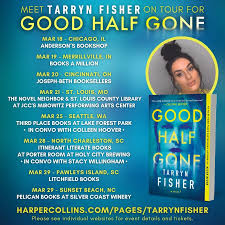I’m all for a good thriller, and often find myself drawn to their titles, covers and/or premises. That’s what happened with Good Half Gone by Tarryn Fisher — an author whose books I’d seen at the library, but had never read. I saw this latest effort on NetGalley, and all three of the facets mentioned above caught my interest, causing me to become intrigued and request a review copy.
Well, I’ve just finished Good Half Gone, after devouring it in about two days. I’m left trying to put words to my thoughts regarding this strange book.
Let’s start from the beginning…
Good Half Gone begins as two twin girls leave school. The fifteen year olds are just about to walk out the door when they’re called by a friend who wants to set the more outgoing one (Piper) up with a guy she likes. They agree to meet at the mall the next day.

After a change of plans, the girls go to the movies with a couple of guys they’d never met before. Afterwards, Piper ends up being kidnapped by said men, and Iris’ phone is stolen. She doesn’t get a good look at the car, and the following investigation has a lot of issues, including cops who don’t take things seriously.
The story is, as you guessed, told from Iris’ first-person perspective, but not linearly. It follows two different timelines, including the past (the mall, the kidnapping and what happened afterwards) and the present, where a now 23 year old Iris is interning at a hospital for the criminally insane, which just so happens to be located on an island off the coast of Seattle, Washington. The main players are Iris, her son, her grandma, the cops and the people she works with, not to mention the inmates; some of which roam free throughout the ward.
This is a novel that starts off pretty strongly, then gets too comfortable for the next 60% of its length, which mostly centres on Iris’ life, the investigation and her time at the hospital. It jumps right into the hospital scenes, too, without telling the reader why she’s there, or who is to blame. There’s a lot of reaching at times, and the reader is just expected to go along with it and say “Ok.”

The middling, ‘fine’ and mostly unexciting middle of Good Half Gone abruptly stops at a sudden climax, which begins due to nonsensical happenings. The event that triggers it didn’t need to happen, given the twists and reveals that follow. Looking back, it makes little sense.
The final twist is also so predictable that it would be part of a class called Thrillers 101. In fact, the last 20% is kind of silly, unrealistic and lacking.
There were other issues that I hope they’ll iron out before the first edition is released. For instance, the math relating to Iris’ son’s age doesn’t compute, with him being listed as 9 at first and then 8 later on. Iris’ age and situation also made me question how realistic it would actually be, and took me out of the book a bit.
I also didn’t appreciate the inference that people who take antipsychotics must be violent in order to need them. I’ve taken two, and I’m not violent at all. They sometimes assist antidepressants.
Then again, there was also an inference that Christian people don’t own TVs.
As a character, Iris was fine. I didn’t mind reading her perspective or her narration, but she didn’t seem all that smart.
I don’t hate this book. I don’t even dislike it. I’m just kind of ho-hum about it. Good Half Gone is a decently written novel, and it kind of hooked me, but the last 20% really hurt my opinion of it, as did the issues mentioned above.
There’s an ok, but rather silly and plodding book to be found here.
This review is based on a digital advanced reader copy, which we were provided. Thank you to NetGalley and HarperCollins for providing us with it. Receiving a free copy did not affect our review or overall opinion.

